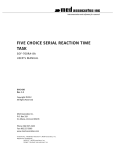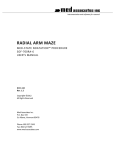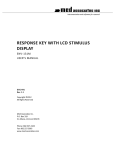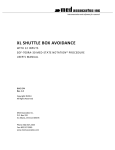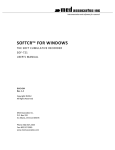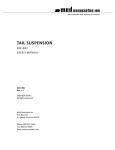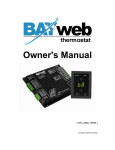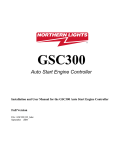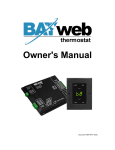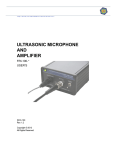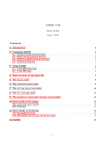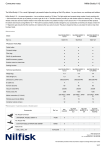Download variable speed infusion pump
Transcript
instrumentation and software for research VARIABLE SPEED INFUSION PUMP WITH SERIAL CONTROL PHM-100VSS USER’S MANUAL DOC-001 Rev. 3.5 Copyright ©2013 All Rights Reserved Med Associates Inc. P.O. Box 319 St. Albans, Vermont 05478 Phone: 802.527.2343 Fax: 802.527.5095 www.med-associates.com PHM-100VSS VARIABLE SPEED INFUSION PUMP notes -iDOC-001 Rev 3.5 Copyright © 2013 MED Associates, Inc. PHM-100VSS VARIABLE SPEED INFUSION PUMP Table of Contents Chapter 1 | Introduction ........................................................................................................ 1 Chapter 2 | Syringe Placement ............................................................................................... 2 Priming the Line............................................................................................................................... 3 Glass Syringes .................................................................................................................................. 3 Chapter 3 | Controlling the Pump in Manual Mode ................................................................. 4 Setting the TIME and RATE Switches............................................................................................... 5 Flow Rates and Pump Speeds.......................................................................................................... 7 MED Control .................................................................................................................................... 8 TTL Control (5V) ............................................................................................................................... 8 Switch Closure Control .................................................................................................................... 8 Chapter 4 | Controlling the Pump in PC Mode ......................................................................... 9 DIG-729 Installation ......................................................................................................................... 9 Wiring Instructions .......................................................................................................................... 9 Controlling the Pump Using MED Test .......................................................................................... 10 Controlling the Pump Using the Included MED-State Notation .................................................... 11 Controlling the Pump Using Custom MED-State Notation............................................................ 12 MED-PC Log Errors ........................................................................................................................ 14 Chapter 5 | Automatic Shut-Off Switch Adjustment .............................................................. 15 Appendix A | PHM-100VSS Addressing Scheme .................................................................... 16 Appendix B | Contact Information ........................................................................................ 17 - ii DOC-001 Rev 3.5 Copyright © 2013 MED Associates, Inc. MED ASSOCIATES INC. P H M - 1 0 0 V SS V AR I A B L E S P E E D I NF U SI O N P U M P CHAPTER 1 | INTRODUCTION The PHM-100VSS provides infusions from 0.1 to 99.9 seconds at rates ranging from 0.5 to 20 RPM. The unit can be operated using a MED interface output bit, a TTL control line, a switch closure, MED-PC, or a computer with the serial control. The PHM-100VSS requires 110 volts, 60 cycle AC. Use part number PHM-100VSSA for 220 volt, 50 cycle applications. The PHM-100VSS requires a DIG-729 High Speed Serial controller card in the operating computer if used with MED-PC. Figure 1-1 – PHM-100VSS Front View -1DOC-001 Rev 3.5 Copyright © 2013 MED Associates, Inc. MED ASSOCIATES INC. P H M - 1 0 0 V SS V AR I A B L E S P E E D I NF U SI O N P U M P CHAPTER 2 | SYRINGE PLACEMENT Care should be exercised to ensure that the hub of the syringe barrel is positioned adjacent to the syringe clamp when loading the syringe pump. If a gap exists between the hub and the clamp, accurate flow rates cannot be assured, as the entire syringe (both barrel and plunger) may move forward. A visual check by observing the plunger move in relation to the barrel by rotating the front knob of the pump is advised. Figure 2-1 illustrates the procedure for loading a syringe into the pump. Figure 2-1 - Loading a Syringe 1. Move the slide to rear (toward motor section) by squeezing the jaws. 2. Insert syringe by lifting clamp cover and placing the syringe body into the clamp. 3. Move the slide to the end of the syringe. 4. Rotate the knob so that the slide makes contact with the plunger and the syringe contacts the clamp. -2DOC-001 Rev 3.5 Copyright © 2013 MED Associates, Inc. MED ASSOCIATES INC. P H M - 1 0 0 V SS V AR I A B L E S P E E D I NF U SI O N P U M P Priming the Li ne Once the syringe is installed, the line should be primed until liquid drips out of the syringe or tubing. This ensures that fluid will be infused properly when the pump is activated. Prime the line by setting the Flush switch in the “down” position for as long as required. The settings of the TIME and RATE switches are not recognized when the Flush switch is on; the pump will operate at 10 RPM and will only operate when a timed infusion is not in progress. Glass Syringes Extra caution should be exercised when using glass syringes with a ground glass plunger. These syringes exhibit almost no sliding friction and thus can cause an uncontrolled infusion in the following two ways: 1. The weight of the plunger may be sufficient to push the fluid out of the syringe if the syringe is held with the plunger above the syringe. 2. The weight of the fluid in the tubing may be sufficient to siphon the fluid out of the syringe if the catheter infusion site is below the height of the syringe. 3. To test for these two conditions, it is suggested that the syringe be connected to the tubing and held vertically at the height of the pump. If no motion occurs, the syringe can then be placed in the pump. The following may reduce the danger of an uncontrolled infusion: 1. Lower the relative height of the infusion pump in relation to the infusion site. With the pump below the infusion site, the instrument will pump the fluid to the higher elevation. 2. Use a smaller bore catheter, which will reduce the weight of the fluid in the tubing and increase the friction on the flowing fluid. 3. Position the pump so that the syringe is vertical (plunger below), thus the weight of the syringe plunger will be acting against the weight of the fluid. Use a syringe with a rubber seal on the plunger, i.e. an O-ring sealed or plastic syringe. -3DOC-001 Rev 3.5 Copyright © 2013 MED Associates, Inc. MED ASSOCIATES INC. P H M - 1 0 0 V SS V AR I A B L E S P E E D I NF U SI O N P U M P CHAPTER 3 | CONTROLLING THE PUMP IN MANUAL MODE The following control options can be used to control the pump when the MODE switch is in the Manual position, as shown in Figure 3-1. The settings of the TIME and RATE switches will determine the duration and rate of the infusion when operating in Manual mode. If the end of the syringe is reached during an infusion the Automatic Shut-Off Switch will be activated and the infusion will be stopped. Refer to the Automatic Shut-Off Switch Adjustment section of this manual for further information. Figure 3-1 - Back Panel of the PHM-100VSS Figure 3-2 - Front Panel of the PHM-100VSS -4DOC-001 Rev 3.5 Copyright © 2013 MED Associates, Inc. MED ASSOCIATES INC. P H M - 1 0 0 V SS V AR I A B L E S P E E D I NF U SI O N P U M P Setti ng the TIME and RATE Switches The duration and speed of the infusion are set using the TIME and RATE pushbutton switches on the front of the PHM-100VSS. The TIME switches are used to set infusion times from 00.0 to 99.9 seconds, and the RATE switch is used to select the pump RPMs, as indicated by the table on the pump, and also shown in Table 3.1. For example, a RATE pushbutton switch setting of 2 would produce a speed of 1.0 RPM. Note that 0 is not used and has no effect. In the example shown in Figure 3-3, the infusion time has been set to 35.0 seconds and the rate is set to 2.0 RPM. If the end of the syringe is reached during an infusion the Automatic Shut-Off Switch will be activated and the infusion will be stopped. Refer to the Automatic Shut-Off Switch Adjustment section of this manual for further information. Figure 3-3 - Example Settings Table 3.1 - RATE Pushbutton Switch Settings RATE Pushbutton Setting Corresponding RPMs 0 N/A 1 0.5 2 1.0 3 1.5 4 2.0 5 3.33 6 5.0 7 10.0 8 15.0 9 20.0 -5DOC-001 Rev 3.5 Copyright © 2013 MED Associates, Inc. MED ASSOCIATES INC. P H M - 1 0 0 V SS V AR I A B L E S P E E D I NF U SI O N P U M P -6DOC-001 Rev 3.5 Copyright © 2013 MED Associates, Inc. MED ASSOCIATES INC. P H M - 1 0 0 V SS SY R I N G E P U M P Flow Rates and Pump Speeds The following table shows the flow rates in milliliters per minute of several commonly used syringes. Thumbwheel Setting Motor RPM 1 mL Multifit 2 mL Multifit 5 mL Multifit 10 mL Plastipak 10 mL Multifit 12 mL Monoject 20 mL Plastipak 20 mL Multifit 20 mL Monoject 30 mL Plastipak 30 mL Multifit 35 mL Monoject 50-60 mL Plastipak Monoject 50 mL Multifit 1 0.50 0.017 0.061 0.106 0.160 0.165 0.193 0.278 0.295 0.323 0.358 0.395 0.437 0.542 0.603 2 1.00 0.034 0.122 0.212 0.320 0.331 0.386 0.557 0.589 0.646 0.715 0.791 0.874 1.084 1.206 3 1.50 0.052 0.184 0.318 0.480 0.496 0.579 0.835 0.884 0.969 1.073 1.186 1.311 1.626 1.809 4 2.00 0.069 0.245 0.424 0.640 0.661 0.773 1.114 1.179 1.292 1.431 1.581 1.748 2.169 2.412 5 3.33 0.115 0.408 0.706 1.066 1.102 1.288 1.856 1.965 2.154 2.385 2.636 2.914 3.614 4.02 6 5.00 0.172 0.612 1.059 1.600 1.653 1.931 2.784 2.947 3.231 3.577 3.954 4.371 5.421 6.031 7 10.00 0.344 1.223 2.118 3.198 3.306 3.863 5.895 5.895 6.462 7.155 7.907 8.741 10.843 12.061 8 15.00 0.516 1.835 3.177 4.798 4.959 5.794 8.353 8.843 9.694 10.732 11.861 13.112 16.264 18.092 9 20.00 0.688 2.446 4.236 6.397 6.612 7.726 11.137 11.789 12.925 14.310 15.814 17.483 21.686 24.122 To calculate the flow rate of a syringe not given above, use the following formula: Flow Rate (mL/min) = 0.19538 * RPM * syringe cross-sectional area -7DOC-001 Rev 3.5 Copyright © 2013 MED Associates, Inc. MED ASSOCIATES INC. P H M - 1 0 0 V SS V AR I A B L E S P E E D I NF U SI O N P U M P MED Control Connect the MED Control connector shown in Figure 3-1 to any available output on a Standard MED Connection Panel using a standard Molex cable. The pinout of the 3-pin Molex connector is shown in Figure 3-4. Upon receiving an operate signal, the pump will begin the infusion the settings of the TIME and RATE switches on the front panel, and then it will stop. The operate signal must be toggled off between infusions. Any changes made to the TIME and RATE settings during an infusion will not be acknowledged. Figure 3-4 - MED Control Connector Pinout Molex Pin # Function 1 Not Used 2 +28 Volts 3 Operate TTL Control (5V) Connect the TTL ground to the (-) screw terminal and the TTL operate signal to the (+) screw terminal. A TTL high to low transition on the operate line activates the pump. CAUTION: Voltage levels above 5.2 VDC at the TTL terminals can damage the unit. Switch Closur e Control Simply connect a switch between the (+) and (-) screw terminals. Closing the switch will operate the pump. The switch must be opened and closed again to activate the pump for another cycle. -8DOC-001 Rev 3.5 Copyright © 2013 MED Associates, Inc. MED ASSOCIATES INC. P H M - 1 0 0 V SS V AR I A B L E S P E E D I NF U SI O N P U M P CHAPTER 4 | CONTROLLING THE PUMP IN PC MODE The supplied software allows the pump to be controlled using MED Test program or MED-PC when the MODE switch is in the PC position. The settings of the TIME and RATE switches are not recognized when operating in PC mode. If the end of the syringe is reached during an infusion the Automatic Shut-Off Switch will be activated and the infusion will be stopped. Refer to the Automatic Shut-Off Switch Adjustment section of this manual for further information. DIG-729 Installation Consult the “DIG-729 High Speed Serial Controller Installation Guide” (MED Associates Part Number DOC-002) for instructions on installing the DIG-729 card. Wiring Instructions Connect the female DB-15 port on the back panel of the PHM-100VSS to the DIG-729 card in the PC using the SG-219C cable provided. Figure 4-1 – Connect Female DB-15 to DIG-729 Card Connect the PHM-100VSS power cord to a standard wall outlet and power on using the lighted ON/OFF switch. To control additional PHM-100VSS pumps, connect them in daisy-chain fashion by connecting the male DB-15 port on the first pump the female DB-15 port on the second pump using an SG219C cable. Up to 16 pumps may be daisy chained together in this fashion. -9DOC-001 Rev 3.5 Copyright © 2013 MED Associates, Inc. MED ASSOCIATES INC. P H M - 1 0 0 V SS V AR I A B L E S P E E D I NF U SI O N P U M P Figure 4-2 – Controlling Additional Pumps NOTE: The length of the SG-219C cables used to connect the pumps should not exceed 10-feet. PHM-100VSS node numbers are factory set and should be clearly labeled on the pump case. The units can be daisy-chained in any order; however, the last unit in a series must have the highest node number and must have the terminate switches ON. In most cases, users will not need to adjust the network address or terminate settings on the PHM-100VSS pump. However, if a new PHM-100VSS pump is being added to an existing daisy-chain network, the network address and terminate settings of the PHM-100VSS pumps may need to be reset. See Appendix A for details on changing network addresses and terminate settings on the PHM-100VSS pump. Contr olling the Pump Using MED Test The MED Test software allows the user to test the PHM-100VSS pumps. MED Test is included on the MED-PC software CD. If an updated version of MED Test is needed, please contact MED Associates for instructions on how to get the latest version. Open MED Test and select Pumps | PHM-100VSS to open the Test Screen. Figure 4-3 - MED Test Screen Enter the node number (the pump should be labeled with this number), the desired rate (RPM), and Infusion Time in seconds. Once these values are entered, click Set Pump to start the PHM100VSS pump. After the data is sent to the pump the pump's status is displayed in the Sum - 10 DOC-001 Rev 3.5 Copyright © 2013 MED Associates, Inc. MED ASSOCIATES INC. P H M - 1 0 0 V SS V AR I A B L E S P E E D I NF U SI O N P U M P Check Sent and Sum Check Rec fields. The two fields should match. If a pump is not responding, check that the power is on and all network connections have been properly made. If necessary, contact MED Associates for further assistance. Once the correct data has been entered and the pump is responding, the pump can be turned on by clicking the Pump On button. A pump may be operated repeatedly with the same data by repeatedly clicking the Pump On button. Contr olling the Pump Using the Included MED -State Notation To control the pump using the program that is included on the PHM-100VSS CD, insert the CD into the CD-ROM drive and click To Install the PHM-100VSS Software. The procedure is copied into the installation directory. Programs written in MedState Notation must be translated using Trans IV before they can be executed in this application. Open Trans IV icon and select Translation | Translate and Compile. Select the program(s) to use and click Make. Click OK to start the translator, and it will automatically parse the MedState Notation and then open to a DOS screen to compile the Pascal code. Depending on the speed of the computer, each of these steps may not be seen. Open MED-PC and the MED-PC Experiment Loading Wizard’s Welcome screen will appear. Follow the steps to load the program, issue a START command or the desired K-pulse by selecting to Configure | Signals. \ Copyright (C) 2008 MED Associates, All rights reserved. \ \ \ \ \ \ \ \ \ PHM100VSS.MPC This program demonstrates how to properly call the MED-PC commands that Start and Stop the PHM-100VSS Pump. The BOX parameter specifies which PHM-100VSS Pump to start. When this program is running in Box 1, then the BOX parameter will equal 1 and Pump 1 will start. When this program is running in Box 2, then the BOX parameter will equal 2 and Pump 2 will start, etc. This allows the same program to be run in multiple Boxes and control different Pumps. \ A() = Control Variables with Assigned Aliases as Defined Var_Alias Duration (0.1 - 99.9 seconds) = D \ Default = 10 seconds Var_Alias Rate (0.5 - 20.0 RPM) = R \ Default = 1 Revolution Per Minute \ List Working Variables Here \ E = Infusion Duration in MED Ticks \ K-Pulses Used in this Program \ K1 = Turn on the Pump at the currently set Rate and then increase the Rate by 1 \ K2 = Turn on the Pump at the currently set Rate and then decrease the Rate by 1 \ K3 = Lock on the Pump at the currently set Rate \ K4 = Turn off the Pump S.S.1, S1, 0.001": SET D = 10, R = 1 ---> S2 S2, #START: ---> S3 1": SHOW 1,Duration,D, 2,Rate,R ---> S2 - 11 DOC-001 Rev 3.5 Copyright © 2013 MED Associates, Inc. MED ASSOCIATES INC. P H M - 1 0 0 V SS V AR I A B L E S P E E D I NF U SI O N P U M P S3, \ Send the values down to the Pump 0.01": ~SetPump(MG, BOX, R, D);~; SHOW 1,Duration,D, 2,Rate,R, 3,Pump Off,0; SET E = D * 1" ---> S4 S4, \ Wait for command to turn the Pump on #K1: ~OnPump(MG, BOX);~; SET R = R + 1; SHOW 3,Pump On,1 ---> S5 #K2: ~OnPump(MG, BOX);~; SET R = R - 1; SHOW 3,Pump On,1 ---> S5 #K3: ~LockOnPump(MG, BOX);~; SHOW 3,Pump On,1 ---> S6 S5, \ Make sure the User can't send another OnPump \ command while the Pump is running. E#T: IF R > 20 [@True, @False] @True: SET R = 20 ---> S3 @False: IF R < 1 [@True, @False] @True: SET R = 1 ---> S3 @False: ---> S3 S6, \ Turn the Pump off #K4: ~LockOffPump(MG, BOX);~ ---> S3 Contr olling the Pump Using Custom MED -State N otati on The PHM-100VSS can be controlled using the included MED-State Notation procedure (PHM100VSS.mpc), or a custom procedure can be created using the following commands. SetPump The SETPUMP command sets all pump parameters to be the same as the specified pump and retains them until they are changed or power is turned off. Syntax: ~SetPump(MG, P1, P2, P3);~ Where: MG = MED-PC Global Pointer P1 = The Pump Node Value (1 to 16) P2 = The Rate (0.5 to 20 RPM) P3 = The Infusion Time (0.1 to 99.9 seconds) Comments: P1 through P3 may be numbers, constants, special identifiers, or variables. Note: Array elements must be expressed using square brackets P[1], not the normal parenthesis ( ) used in MEDSTATE NOTATION. OnPump The ONPUMP command selects the pump node and turns that pump on. It is not necessary to issue a SETPUMP command each time the pump is turned on. Allow at least one clock tick between the SETPUMP command and the ONPUMP command; i.e., do not place both commands in the same State. Syntax: ~OnPump(MG, P1);~ Where: MG = MED-PC Global Pointer P1 = The Pump Node Value (1 to 16) - 12 DOC-001 Rev 3.5 Copyright © 2013 MED Associates, Inc. MED ASSOCIATES INC. Comments: P H M - 1 0 0 V SS V AR I A B L E S P E E D I NF U SI O N P U M P P1 may be a number, constant, special identifier, or variable. Note: Array elements must be expressed using square brackets P[1], not the normal parenthesis ( ) used in MEDSTATE NOTATION. LockOnPump The LockOnPump command selects the pump node and locks on the pump until a LockOffPump command is sent. Syntax: ~LockOnPump(MG, P1);~ Where: MG = MED-PC Global Pointer P1 = The Pump Node Value (1 to 16) Comments: P1 may be a number, constant, special identifier, or variable. Note: Array elements must be expressed using square brackets P[1], not the normal parenthesis ( ) used in MEDSTATE NOTATION. LockOffPump The LockOffPump command selects the pump node and turns off the pump. It can even turn off the pump when it was turned on with the PumpOn command. Syntax: ~LockOffPump(MG, P1);~ Where: MG = MED-PC Global Pointer P1 = The Pump Node Value (1 to 16) Comments: P1 may be a number, constant, special identifier, or variable. Note: Array elements must be expressed using square brackets P[1], not the normal parenthesis ( ) used in MEDSTATE NOTATION. MedState Notation Examples The following two examples are functionally equivalent. A five second infusion at 3.33 RPM is used as the reinforcer for an FR-10 schedule. Example A: S.S.1, S1, 0.01": ~SETPUMP(MG, BOX, 3.33, 5);~ ---> S2 S2, 10#R1: ~ONPUMP(MG, BOX);~ ---> S2 Example B: LIST P = 0, 3.33, 5 S.S.1, S1, 0.01": SET P(0) = BOX; ~SETPUMP(MG, P[0], P[1], P[2]);~ ---> S2 S2, 10#R1: ~ONPUMP(MG, P[0]);~ ---> S2 - 13 DOC-001 Rev 3.5 Copyright © 2013 MED Associates, Inc. MED ASSOCIATES INC. P H M - 1 0 0 V SS V AR I A B L E S P E E D I NF U SI O N P U M P MED-PC Log Errors If a pump parameter is improperly specified or a pump is not responding, MED-PC will flag the error in the log files. The following list describes the errors and how to correct them: Error [1] Pump is not responding [2] Rate must be between 0.5 and 20 RPM [3] Duration must be 0.1 to 99.9 seconds. [4] Pump halted due to errors Cause Correction The pump specified by SETPUMP did not return the proper checksum within the time required. Check that a pump with that number exists in the system. Verify that the unit's power is on. Check all network cabling. Refer to page 1 for electrical connection information. Try operating the unit using the MED Test program. Call MED Associates for assistance if necessary. Rate is not set within the allowable range. Verify that the proper rates are used. Refer to the Controlling the Pump Using Custom MED-State Notation section of this manual. Duration is not set within the allowable range. Verify that the proper durations are used. Refer to the Controlling the Pump Using Custom MED-State Notation section of this manual. ONPUMP command not allowed due to errors in a previous SETPUMP command. Check the log for previous errors and refer to the listings above for explanations. - 14 DOC-001 Rev 3.5 Copyright © 2013 MED Associates, Inc. MED ASSOCIATES INC. P H M - 1 0 0 V SS V AR I A B L E S P E E D I NF U SI O N P U M P CHAPTER 5 | AUTOMATIC SHUT-OFF SWITCH ADJUSTMEN T The automatic shut-off switch is activated when the pump reaches the end of the syringe, causing the pump motor to cease operation. The automatic shut-off switch uses an internal micro-switch that detects when the slide assembly reaches a certain point. This point is adjustable so that the pump can accommodate various sizes and brands of syringes. To adjust the automatic shut-off switch, insert an empty syringe with the plunger at the desired shut-off position. Move the slide assembly to the rear of the plunger (Figure 5-1A). With the pump turned on, switch the Flush switch on and rotate the adjustment screw (Figure 5-1B) until the pump stops operating. Turning the screw clockwise will allow the pump to operate longer before the automatic shut-off switch activates. Conversely, turning the screw counterclockwise will cause the automatic shut-off switch to activate sooner. In order to reset this switch and resume pump operation the slider must be moved back until the Automatic Shut-Off Switch is deactivated. Figure 5-1 – Automatic Shut-Off Switch Adjustment - 15 DOC-001 Rev 3.5 Copyright © 2013 MED Associates, Inc. MED ASSOCIATES INC. P H M - 1 0 0 V SS V AR I A B L E S P E E D I NF U SI O N P U M P APPENDIX A | PHM-100VSS ADDRESSING SCHEME The PHM-100VSS pump address settings should only be modified if a new pump is being added to an existing network. If the pumps have been purchased from MED Associates as part of a package or system, the addresses have been factory set and there is no need to adjust these settings. To change the address or termination settings of a PHM-100VSS pump, remove the two recessed screws from the bottom panel of the unit. There is an 8-position dipswitch that resembles Figure 5-2. Figure 5-2 - PHM-100VSS Dipswitch Switches 1 through 4 are used for setting the pump’s address according to Table 5.1. Switches 6, 7, and 8 are used for differential line terminations, which are preset at the factory. Do not change unless adding additional pumps to the configuration. Only the last pump in the series should have switches 6, 7, and 8 set to ON. All other pumps should have these switches set to OFF. Switch 5 is not used. In Figure 5-2 the pump address is set to 1 and since the terminate switches are all ON, it is the last pump in the series. - 16 DOC-001 Rev 3.5 Copyright © 2013 MED Associates, Inc. MED ASSOCIATES INC. P H M - 1 0 0 V SS V AR I A B L E S P E E D I NF U SI O N P U M P Table 5.1 - Address Switch Positions Switch Number Pump Address 1 2 3 4 1 OFF ON ON ON 2 ON OFF ON ON 3 OFF OFF ON ON 4 ON ON OFF ON 5 OFF ON OFF ON 6 ON OFF OFF ON 7 OFF OFF OFF ON 8 ON ON ON OFF 9 OFF ON ON OFF 10 ON OFF ON OFF 11 OFF OFF ON OFF 12 ON ON OFF OFF 13 OFF ON OFF OFF 14 ON OFF OFF OFF 15 OFF OFF OFF OFF 16 ON ON ON ON APPENDIX B | CONTACT INFORMATION Please contact MED Associates, Inc. for information regarding any of our products. Visit our website at www.med-associates.com for contact information. For technical questions, email [email protected]. - 17 DOC-001 Rev 3.5 Copyright © 2013 MED Associates, Inc.
























